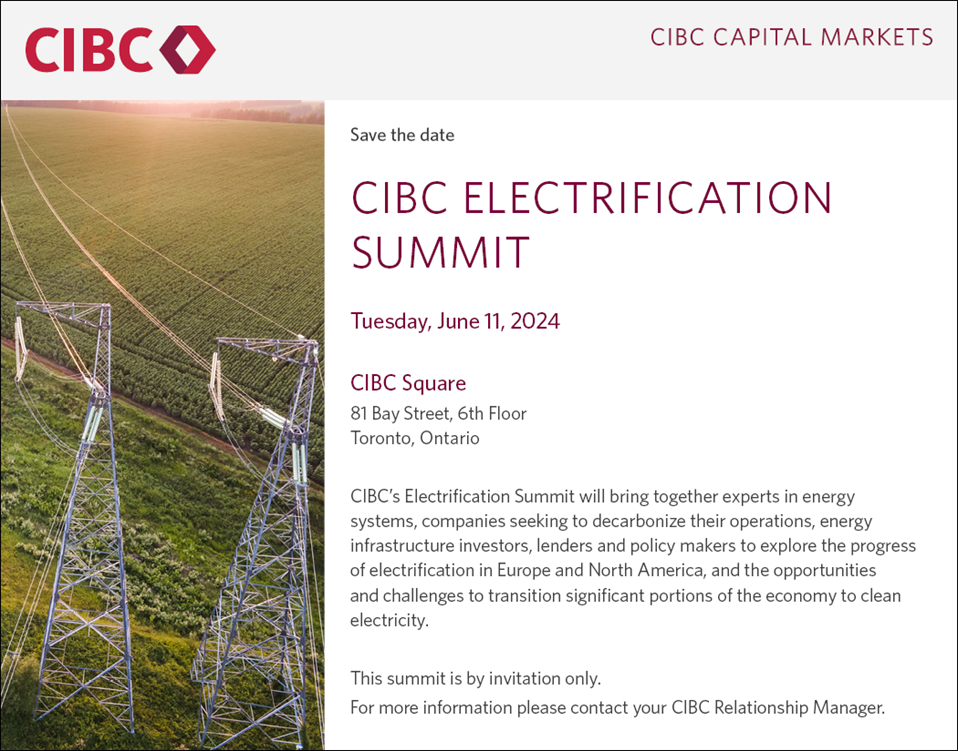

- 'Two-thirds of all vehicles sold in 2035 could be electric'
- 3 key solutions to modernize the US electricity grid
- Decarbonizing the built environment – Key takeaways for the sector
- What we learned at North American Carbon World 2024
- Calls for sustainable finance taxonomy in Canada become more urgent
- ISSB eyes nature-related corporate disclosure standards
- An update on Canada’s carbon related policies and incentives
- The ‘meat’ of the climate issue for food and agriculture companies
- Charting the market
- Thought Leadership
Top Story
'Two-thirds of all vehicles sold in 2035 could be electric'
The International Energy Agency (IEA) released a flagship Global EV Outlook 2024 report, examining the deployment of electric vehicles (EVs) and charging infrastructure, battery demand, investment trends, and related policy developments. It finds that global EV sales remain strong, despite industry challenges.
Quick recap: According to the report, EV sales grew 25% in the first three months of 2024, over the same period in 2023. By the end of 2024, global EV sales are projected to reach 17 million, potentially surpassing the record-breaking 14 million (18% of all cars sold) in 2023. China is expected to account 45% of EV sales, the EU 25%, and the US 11%. This growth is expected despite industry challenges that have hampered market confidence. Tight margins, volatile battery metal prices, high inflation, and the phase-out of purchase incentives in some countries have sparked concerns about the industry’s pace of growth.
However, supportive policies and industrial incentives have been key to boosting investments in the EV supply chain, continuing to reinforce expectations for rapid electrification. The report notes that between 2022 and 2023, investment announcements in EV and battery manufacturing totaled USD $500 billion, of which 40% has been committed. It also highlights that enough battery manufacturing capacity has reached final investment decision to deliver on announced pledges from automakers and governments globally. If all the national energy and climate targets made by governments are met in full and on time, two-thirds of all vehicles sold in 2035 could be electric.
Why is this interesting? There have been growing concerns about the pace of transition to EVs, exacerbated by recent inventory and pricing trends plaguing EV giant Tesla. As of 2023, 20 original equipment manufacturers (OEMs), representing 90% of global car sales, announced goals for future EV rollout. Although some have missed or delayed near-term targets, they have not scaled back on longer-term ambitions. Honda just announced a C$15 billion investment to build an EV assembly and battery supply chain in Canada, capable of producing up to 240,000 vehicles per year from 2028.
Energy Transition & Decarbonization
3 key solutions to modernize the US electricity grid
The Rocky Mountain institute (RMI) published Big wires, small wires and non-wires solutions to ‘electrify everything’, making the case on how to modernize transmission and distribution systems to support a fully electrified economy.
Quick recap: According to RMI, the US electric grid is already reaching capacity to deliver on current power needs, let alone be capable of delivering 2x to 3x the amount of power to meet future needs. Therefore, an approach that deploys large- and small-scale hardware and software solutions can help to ensure the system is able to support varied electrified end-uses.
‘Big wires solutions’ involve not only expanding new high-voltage, long-distance transmission lines, but upgrading existing lines too. Grid-enhancing technologies (GETs) and advanced conductors can be used to transmit more power through existing transmission corridors, avoiding lengthy permitting processes that delay new power lines. ‘Small wires solutions’ would require utilities to proactively invest in distribution infrastructure (especially in new areas) to accommodate localized power demands such as from electric vehicle charging, and heat pumps in buildings. ‘Non-wires solutions’ include a role for virtual power plants (VPPs) which use software to allow devices that are already in homes and businesses to help power communities and contribute to demand flexibility during times of increased load. Deployed at scale, VPPs could reduce the pressure from growing electricity demand without having to wait years for investment in power lines and other conventional infrastructure.
Why is this interesting? The Biden Administration has made delivering clean electricity a top climate agenda priority. His latest announced actions include funding for a 285-mile transmission line form Idaho to Nevada, new rules to make federal permitting of new transmission lines and upgrades to existing transmission lines more efficient, and mobilizing public and private sector to set an ambition to upgrade 100,000 miles of transmission lines over the next five years. Additionally, a new government report issued pursuant to an Executive Order examines the potential for artificial intelligence to improve planning, permitting, investment, and operations for electric grid infrastructure.
Decarbonizing the built environment – Key takeaways for the sector
From April 17-18, 2024, the Building Decarbonization Alliance hosted a Canadian National Building Decarbonization Forum: Pathways to Electrification. Here are our key takeaways from attending the event.
Quick recap: The event brought together government, utilities, real estate developers, financial institutions, energy consultants and others to discuss the main challenges and opportunities to transition Canada’s building sector. One key theme was the need for, and the extent to which, all levels of government within Canada are actively developing policies, regulations, and tools to drive decarbonization of existing buildings. A powerful example is Montreal’s by-law banning GHG-emitting heaters in new buildings in the residential, commercial, and institutional sectors. This by-law comes into force starting on October 1, 2024, for small buildings.
In addition, financial partners made the case that building retrofit projects can benefit from innovative models that re-shape the capital mix and blend-in low-cost financing to reduce investment barriers and meet economic hurdles. As Canadians face a housing affordability crisis, green, low-carbon and resilient buildings are frequently perceived as economically unattainable. However, financial, design and operational innovation, can help achieve not just zero-emissions and climate resiliency, but affordability too.
Why is this interesting? Decarbonizing the building sector has been the focus of newly announced policies in other regions too. The US Department of Energy (DOE) released its first-ever federal blueprint to decarbonize America’s buildings sector, outlining a plan to reduce greenhouse gas emissions from buildings by 65% by 2035 and 90% by 2050. Targets are based on increasing building energy efficiency; accelerating onsite emissions reduction; transforming the interactions between buildings and the electricity grid; and minimizing emissions from producing, transporting, installing, and disposing of building materials. Similarly, the EU announced new rules to improve the energy performance of buildings, requiring new buildings to be zero-emissions by 2030, and the stock of existing buildings to meet zero-emissions by 2050.
Carbon Markets
What we learned at North American Carbon World 2024
Climate Action Reserve’s North American Carbon World (NACW) 2024 – a premier event on carbon markets and climate policy – was held in March. Ryan Fan, Vice Chair and Managing Director, CIBC Global Markets provides useful insights and key takeaways from the event.
Quick recap: Discussions around the voluntary carbon market (VCM) continued to focus on integrity concerns. While supply-side initiatives from the Integrity Council for the Voluntary Cabron Markets (ICVCM), such as the Core Carbon Principles, and demand-side initiatives from the Voluntary Carbon Markets Initiative (VCMI), such as the Claims Code of Practice, aim to address many of these concerns, some major market participants feel that current ICVCM and VCMI standards, as proposed, may not be effective for hard to abate sectors. More broadly, there continues to be a lack of market demand for voluntary carbon credits as the same early adopters – largely from the tech industry – continue to represent the majority of demand. While forward demand signals for high quality credits are forming, there still isn’t either reasonable volume being delivered, or reasonable price for 5-10 years. Many were in agreement that better educational tools for corporates are needed if broader demand formation is to be encouraged.
Why is this interesting? Voluntary carbon credits can play an important role in corporate decarbonization strategies. Large companies have been advocating the use of portfolios of offsets to help meet value chain scope 3 targets. On April 9, 2024, a statement from the Science-Based Targets Initiative (SBTi) – which sets the framework for corporate net-zero target setting – announced it would recognize the use of environmental attribute certificates, like VCM credits, for scope 3 abatement purpose. The move was seen as a boon for the voluntary market, with the potential to stimulate much needed demand signals. However, SBTI later retracted the statement, further weighing down market confidence.
Sustainable Finance
Calls for sustainable finance taxonomy in Canada become more urgent
200+ organizations, led by members of Canada’s Clean50, issued an open letter calling on the federal government to move forward with a clean investment taxonomy or risk competitive disadvantage for its emerging clean tech and transitioning carbon-intensive sectors.
Quick recap: The open letter has been endorsed by major insurance companies, pension funds, investment firms, clean tech companies, venture capital firms, and others – representing billions of dollars of capital presently invested in Canadian companies. The letter underscores the urgent need for a taxonomy that would provide investors with sustainable investment guidelines to target capital more confidently to transition projects, including those in hard-to-abate sectors. A taxonomy would not only help Canada’s emerging and established clean tech companies to access the funding they need to expand and compete globally but also help companies to finance their transition plans and decarbonize more quickly, foster new climate innovations, reduce greenwashing, and enhance transparency in corporate disclosures.
In 2021, the federal government appointed the Sustainable Finance Action Council (SFAC) to provide recommendations on defining green and transition investment, culminating with the release of a Taxonomy Roadmap Report in September 2022. But Ottawa has yet to formalize SFAC’s recommendations, preventing the next stage to start, such as work on technical specifications for green and transition investments by industry, and setting-up a legal structure and a date for the taxonomy to come into force.
Why is this interesting? Canada has become an outlier among its international peers. Every other member of the G7, the EU, and dozens of other nations have established criteria for what constitutes a sustainable investment, with some further defining eligible transition activities. In December 2023, Singapore launched criteria defining green and transition activities across 8 sectors, including energy, transportation, agriculture, and Carbon Capture and Sequestration. This month, Australia begins consultation on its draft criteria for three high-emitting priority sectors: electricity, mining and metals, and the built environment. As global climate agendas become increasingly ambitious, Canada will need to catch-up. A statement from the G7 Ministers of Climate, Energy and Environment – who met last month – committed to ‘promoting and facilitating the scale-up of investments in the industrial sector’.
Governance & Policy
ISSB eyes nature-related corporate disclosure standards
The International Sustainability Standards Board (ISSB) revealed it will begin work on the next iteration of sustainability disclosure standards related to biodiversity, ecosystems, ecosystem services, and human capital, to meet growing investor need for improved disclosure in these areas.
Quick recap: In June 2023, the ISSB had released a set of general standards on how sustainability reporting should be presented. The standards, IFRS S1 on general requirements for disclosure of sustainability-related financial information, and S2 on climate-related disclosures, integrate the recommendations of preceding sustainability frameworks, such as the Sustainability Standards Accounting Board (SASB) and Taskforce on Climate-related Financial Disclosures (TCFD). ISSB had left the door open on whether to consider providing general and industry-specific guidance on other topics.
In its latest announcement, the ISSB will undertake research over the next two years to develop specific guidance for report preparers on nature-related and human capital issues. It is expected the ISSB may build on existing standard-setting initiatives, such as the final recommendations from the Taskforce on Nature-related Financial Disclosures (TNFD). At this time, the ISSB decided not to develop guidance related to the risks and opportunities associated with human rights—beyond those relating to a company’s own workforce and workers in its value chain.
Why is this interesting? TNFD’s final recommendations have already been adopted by 320 corporate and financial institutions globally and many have begun publishing TNFD-aligned disclosure reports. TNFD also informs the reporting landscape in Europe which has required climate and nature-related disclosures since 2023 under the Corporate Sustainability Reporting Directive (CSRD). More of the world is rapidly favoring the disclosure of climate-related and an increasing spectrum of sustainability-related issues, which means more companies will face direct and indirect pressures to align their corporate reporting.
An update on Canada’s carbon related policies and incentives
There have been a number of key carbon related policies and incentives announced in Canada during the month of April. They are worth summarizing here.
Quick recap: On April 1, 2024, two important developments took effect. Canada’s federal carbon price increased from C$65 to C$80 per tonne, which will impact consumers and businesses who purchase fossil fuels in Canada (however, British Columbia and the Northwest Territories have their own, very similar carbon charge for consumers, and Quebec has a cap-and-trade system which is quite different but considered equivalent by the federal government). Meanwhile, British Columbia’s Output-Based Pricing System (OPBS) became mandatory for industrial operations that emit over 10,000 tons of carbon dioxide equivalent (tCO2e) per year.
On April 16, 2024, the federal government published its Budget 2024. Among the carbon-related provisions, the Canada Growth Fund (CGF) – the federal entity which issues carbon contracts for difference (CCfDs) – is looking to develop an expanded range of CCfD offerings, including ‘off-the-shelf’ contracts for certain jurisdictions and ways to offer these contracts on a competitive basis for a set number of emissions reductions. Additionally, the Budget announced that up to C$500 million per year will be dispersed from the Clean Fuel Regulations’ compliance payment revenues to support biofuel production in Canada, with a focus on renewable diesel, sustainable aviation fuel (SAF) and renewable natural gas. Additional investments benefiting biofuels will also be made by the Canada Infrastructure Bank.
Why is this interesting? The wider response to some of these developments has been mixed. However, an open letter from economists on Canadian carbon pricing aims to debunk certain critiques, and climate policy organization, Clean Prosperity, sees the budget as making important progress on CCfDs. The government’s support for biofuel production will also help to spur a burgeoning industry. According to the Clean Fuels Association, some C$12 billion in biofuel projects are waiting final investment decision in Canada over the next year.
Emerging Sustainability Themes
The ‘meat’ of the climate issue for food and agriculture companies
The World Resources Institute (WRI) published a new report, Toward “Better” Meat? Aligning Meat Sourcing Strategies with Corporate Climate and Sustainability Goals, examining the links between meat production, climate change and other aspects of sustainability impacting the global food and agriculture industry.
Quick recap: According to the report, animal agriculture—including meat and dairy production—is responsible for more than three-quarters of agricultural land use, contributes 11–20% of global greenhouse gas emissions, and emits more than 30% of global methane. Animal agriculture is also a major cause of deforestation and land-use change. With an increasing global population, food insecurity may be further exacerbated.
The report advocates the use of alternative strategies to source higher-welfare meat products that reduce greenhouse gas emissions and other environmental impacts from meat production. To help food and agriculture companies adjust their meat sourcing strategies in a way that maximizes co-benefits for climate, nature, and animal welfare, the report makes key recommendations, including: companies should calculate the emissions baseline of their food purchases; shift from high-emissions products like beef and lamb toward lower-emissions products like plant-based foods and alternative proteins; define meat sourcing priorities by product (e.g., lower-emissions beef, higher-welfare chicken); and engage with suppliers to improve practices and track progress.
Why is this interesting? In December 2023, 134 nations endorsed COP28’s Declaration on Food and Agriculture which commits billions of dollars to adapt and transform the food and agriculture sector from climate change. More than 25 of the world’s leading food companies had also pledged to scale regenerative agriculture practices and to leverage their procurement power to drive demand for sustainably produced farming products. A review of the collective progress on these pledges will take place at COP29 with next steps for 2025 and beyond.
Charting the market
The volume of sustainable finance debt increased in the first quarter of 2024 to $377 billion, compared to $285 billion in the first quarter of 2023.
Below is a breakdown of volumes by product type.


Sustainability across CIBC
At CIBC, we are focused on our goal to make sustainability a reality for our clients and the communities we serve. Whether through greening their balance sheet or providing sustainability advisory services, our objective is to help our clients become global leaders in environmental stewardship and sustainability.
Thought Leadership
Events

Videos
Banking the Transition
Roman Dubczak, Deputy Chair of Capital Markets, hosted a discussion with our energy transition team in the United States, James Wright, Managing Director and Co-Head of US Corporate Banking, and Luisa Fuentes, Managing Director & Head of Energy Transition & Sustainable Finance, US Corporate Banking to look at the impact of current US energy policies, the opportunities for growth, and how the Inflation Reduction Act has shaped the energy sector both in the US and Canada.
Q1 2024 Update – Sustainable Finance
With a shift from voluntary to mandatory sustainability reporting requirements on the horizon, Roman Dubczak, Deputy Chair, CIBC Capital Markets, hosted a discussion with sustainable finance experts, Siddharth Samarth, Managing Director & Head of Sustainable Finance, and Amber Choudhry, Managing Director, Debt Capital Markets, to share the developments shaping future sustainability disclosures, notable transactions in the first quarter of 2024, and trends in the global sustainable finance market.
Podcasts


The CIBC logo and “CIBC Capital Markets” are trademarks of CIBC, used under license.
Key Contacts












































